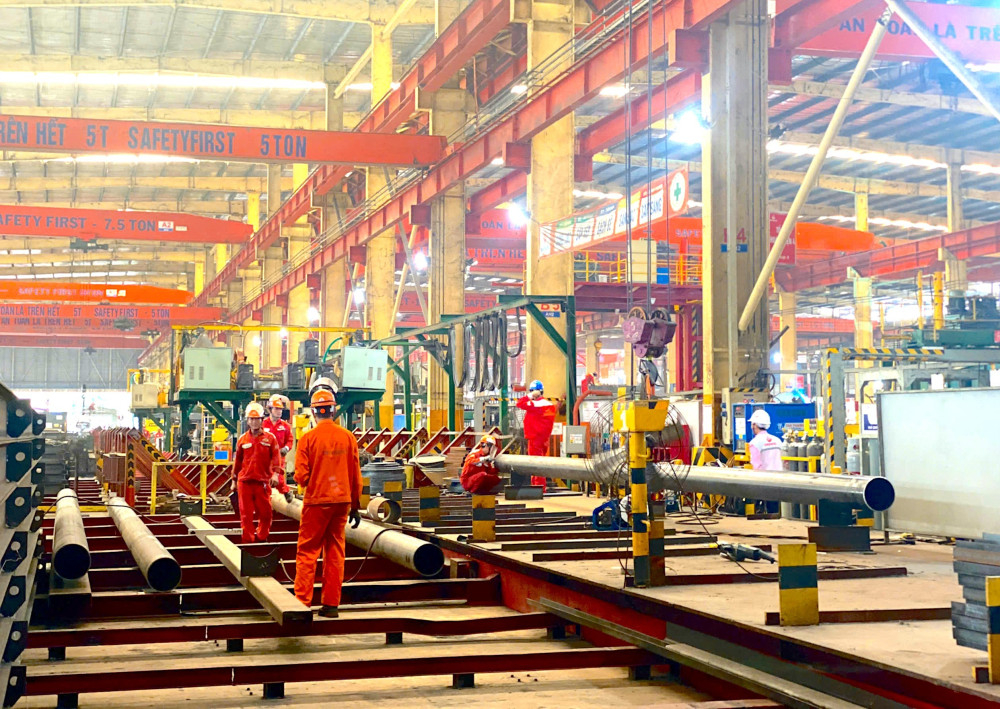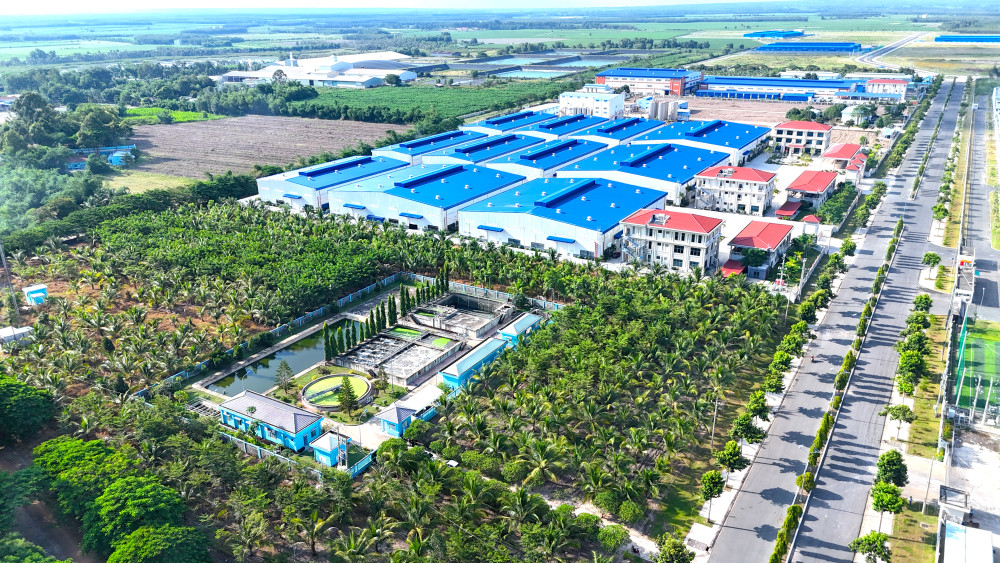Tất cả chuyên mục

For many years, Long An (old) has always been the leading flag of the Mekong Delta region in terms of state budget revenue. The province is also the only locality in the whole region capable of balancing revenue and expenditure and regulating the budget to the Central Government. After the merger, not only is there a change in administrative boundaries, but it also opens up space for Tay Ninh to develop and attract domestic and foreign investment. This is the premise for the province to make a breakthrough in budget revenue, contributing to the target of double-digit growth in 2025.

Aspiration to break through
From 2023, Long An (old) officially could balances its own revenue and expenditure budget, no longer depending on support from the Central Government. In 2024, the state budget revenue reached 33,278 billion VND, making a great contribution to the Southern Key Economic Zone. This result not only demonstrates internal strength but also affirms the success of the strategy of developing industry, services, and high-tech agriculture - 3 pillars that create sustainable revenue.
One of the factors that helped Long An achieve outstanding results is the open investment environment, always ranking at the top of the country in terms of the Provincial Competitiveness Index (PCI). The province focuses on building digital government, simplifying procedures, and minimizing hassles for businesses. Tax and Customs sectors always accompany enterprises, considering enterprises as a source of budget nourishment instead of focusing on short-term collection.

With the advantage of developing agriculture, industry, tourism, transport infrastructure and being an important strategic location in the Southeast region, along with the strong foundation of Long An (old) and the continuous efforts of the entire political system after the merger, the new Tay Ninh is realizing the goal of becoming a fairly developed province of the country, contributing to the economic development of the South, the driving center connecting Vietnam with the ASEAN region. Tay Ninh province identifies state budget collection as a key task, closely linked to the goal of sustainable socio-economic development.
According to Mr. Nguyen Ngoc Minh Sang - Deputy Head of Taxation of Tay Ninh province, the province has drastically implemented many solutions on revenue management, from unifying the database and procedures of the two merged provinces to classifying and re-evaluating taxpayers and potential revenue sources, focusing on groups: large enterprises; key enterprises; industrial parks, industrial clusters, and business households and individuals. "Tay Ninh Provincial Tax has been implementing appropriate management solutions to avoid revenue loss and ensure fairness in tax obligations" - Mr. Nguyen Ngoc Minh Sang said.
|
In 2017: Long An (old) officially joined the 10,000 billion VND club when budget revenue reached 12,321 billion VND. In 2023: Long An (old) state budget revenue reached nearly 26,819 billion VND. Long An (old) officially balanced its own budget, regulated the budget to the Central Government, an important step forward in public finance management. In 2024: Long An (old) state budget revenue reached 33,278 billion VND, making a great contribution to the Southern Key Economic Zone. 2025: By August 18, 2025, the total budget revenue of Tay Ninh province reached 29,494 billion VND, 94% of the central budget estimate, showing the possibility of completing and exceeding the annual plan. Target: In 2025, the budget revenue is expected to reach 25,000-30,000 billion VND, making Tay Ninh one of the localities with high budget revenue scale. |
Tay Ninh currently owns 46 industrial parks and clusters, with a total planned area of over 139,700 hectares with 37,234 registered enterprises, and a total capital of 912,000 billion VND. In 2025, many large corporations in the fields of electronics, precision mechanics, and renewable energy have been promoting investment in Tay Ninh. This will be an important driving force for increasing state budget revenue, ensuring long-term efficiency and being consistent with the orientation of sustainable development.
According to Tay Ninh Provincial Tax, the key sectors contributing budget revenue are Industry - Processing, revenue from land and real estate. Industry - Processing is the spearhead sector and accounts for the largest proportion of revenue, focusing on industrial parks and industrial clusters: including many large industrial parks along National Highway 1, National Highway N2; Trang Bang, Phuoc Dong, Linh Trung industrial parks. In addition, the Trade - Service - Logistics sector, focusing on road transport enterprises, warehouses, freight forwarding, etc., is assessed as a group with a fast growth rate and increasingly contributing to the budget. In addition to the above key sectors, Tay Ninh province after the merger also promotes the exploitation of revenue from a number of other potential sectors such as: High-tech agriculture, Electricity and renewable energy, etc.
By August 2025 (from January 1 to August 18, 2025), the Tax sector of Tay Ninh province collected 29,494 billion VND, reaching 94% of the central estimate, 92.7% of the local estimate and equal to 134.5% compared to the same period in 2024. This result is thanks to taking advantage of the scale, diversity of industries and potential of the two provinces, the key to creating a breakthrough in the work of collecting the state budget. "It is completely possible for the Tax sector of Tay Ninh province to exceed the estimate in 2025" - Mr. Nguyen Ngoc Minh Sang emphasized.
|
After the merger, the Tax Department of Tay Ninh province has a good chance of exceeding the 2025 budget estimate. To achieve that result, the most important thing is to be proactive, determined and synchronous in implementing solutions to collect the State budget. Taking advantage of the scale, industry diversity and potential of both old localities will be the key to creating a breakthrough in budget collection. Deputy Head of Tay Ninh Provincial Tax Department Nguyen Ngoc Minh Sang |
Foundation for sustainable growth
The merger creates a premise for economic development with many potentials in land, labor and infrastructure to attract higher quality foreign direct investment (FDI), forming a comprehensive and solid budget collection strategy for 2025 and the following years. FDI enterprises are currently a factor that has contributed greatly to state budget collection, especially corporate income tax. According to Tay Ninh Provincial Tax Department, by August 18, 2025, revenue from the FDI enterprise sector reached 4,105 billion VND, an increase of 34.5% over the same period in 2024.
After the merger, Tay Ninh becomes a key gateway for trade with Cambodia and the Mekong sub-region. Border gate system The expansion and rearrangement have quickly created a breakthrough in the volume of import and export goods. This is a great opportunity for localities to increase revenue from import and export taxes, while promoting economic and trade development in border areas. Moc Bai, Xa Mat, Tan Nam and Binh Hiep International Border Gates will become an important part contributing to revenue growth. When import and export goods increase rapidly, it will create large revenue from import and export taxes, service fees and border trade activities, etc. By August 14, the total budget revenue of the Department was 4,348 billion VND, reaching 74% of the target assigned by the Prime Minister, an increase of 18% over the same period in 2024, reaching 63% of the target.

However, trade fraud and smuggling across the border are increasingly sophisticated, posing a potential risk of losing state budget revenue. According to the Deputy Department Head of Customs Region XVII Le Nam Quoc, the application of e-customs with modern solutions such as the VNACCS/VCIS system, risk management, electronic payment, electronic invoices, inter-sectoral connection, etc. is becoming a key tool to help Tay Ninh effectively manage import and export activities. Not only reducing cumbersome procedures, e-customs also contributes to making the process transparent, preventing tax losses; speeding up customs clearance, increasing voluntary compliance; integrating data, collecting correctly - collecting enough - collecting on time, creating a transparent and favorable environment for businesses, thereby increasing import and export turnover and sustainable revenue for the state.
From the achievements of Long An (old) to the efforts of Tay Ninh today, we can see the spirit of innovation, daring to think, daring to do, taking businesses and people as the center. That is the foundation for the State budget revenue to continuously grow. The target of 25,000-30,000 billion VND in 2025 is not the final destination but a stepping stone for a long-term journey, towards a modern industrial - service province, a dynamic economic center of the Southern region, contributing significantly to the overall development of the country./.
|
In the first months of 2025, the socio-economic situation of Tay Ninh province continues to maintain its development momentum. The economic growth rate in the first 6 months of 2025 reached 9.63%. With this result, Tay Ninh ranks first in the southern provinces/cities and 7th out of 34 provinces and cities nationwide. Total state budget revenue by mid-August 2025 reached more than 33,000 billion VND. The economic structure continues to shift in the right direction. In the remaining months of 2025, Tay Ninh has proposed many solutions to complete the state budget estimate. In particular, focusing on mobilizing resources to ensure revenue sources, in line with economic development - local society; pay attention to, closely direct, and monitor the fluctuations of revenue sources, especially key revenue sources in the area to ensure appropriate mobilization into the State budget. The province continues to pay attention to directing tax agencies to coordinate with local authorities, especially newly established communes, to process tax records conveniently and transparently for people and businesses. Thanh My |
By Thao Trang - Translated by Q. Thien
Ý kiến ()